![]()
''I've been studying dust since 1965 and I've never seen anything like this,'' said Joseph
Prospero, the director of the Cooperative Institute for Marine and Atmospheric
Studies at the University of Miami. ''It's just incredible.''
"The particulates in the dust clouds that reduce
visibility and cause respiratory problems have not been
measured in such high volume since Mt. St. Helens erupted, and even then, the particulates
did not
reach the ground as they are in this case."
NASA Goddard Space Flight Center, April 2001
"So thick was the dust over Easter weekend that visitors to
western U.S. national parks have reportedly been asking rangers where the "fire"
is. Normally only smoke from major fires causes such haze."
Discovery Channel Earth Alert, April 2001
(Update: A second Asian Haze event was confirmed by NOAA on April 24th. This cloud was also visible in Page, Arizona. See Page 3 for photo and link to NOAA press release.)
(Update: A third Asian Haze event was confirmed on Sunday, April 27 and Monday, April 28th across Page, Arizona.)
For more information on the April 2001 events, Go to Page 2 and Page 3
Current weather observation from Beijing, China
Current weather observation from Hohhot, China
See the current Asian Wind Speed Map
Current weather observation from Lanzhou, China
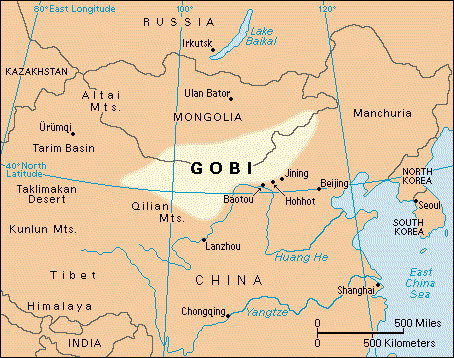
Springtime weather in Asia produces intense wind storm events that can pass over the Gobi Desert along the northern China / Mongolia border and other parts of desert China. These winds are capable of generating huge yellow clouds of suspended dust which based on the direction of the prevailing wind can be sent out to sea.
Recent advances in satellite imagery allow the tracking and documentation of these huge Asian aerosol clouds. Sometimes these dust storms are so immense that they can complete a 5-7 day journey across the Pacific Ocean to impact North America.
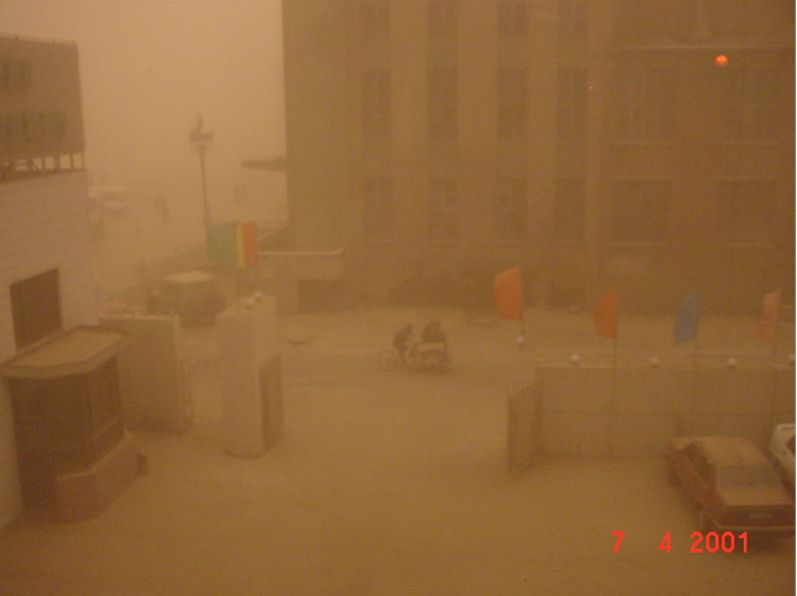
Baicheng (Beijing) Dust Storm - April 7, 2001
(Photos Courtesy of Prof. Zev Levin, The Goldemberg Chair in Atmospheric Physics,
Department of Geophysics and Planetary Sciences, Head, The Porter School in Environmental
Studies, Tel Aviv University, Israel)
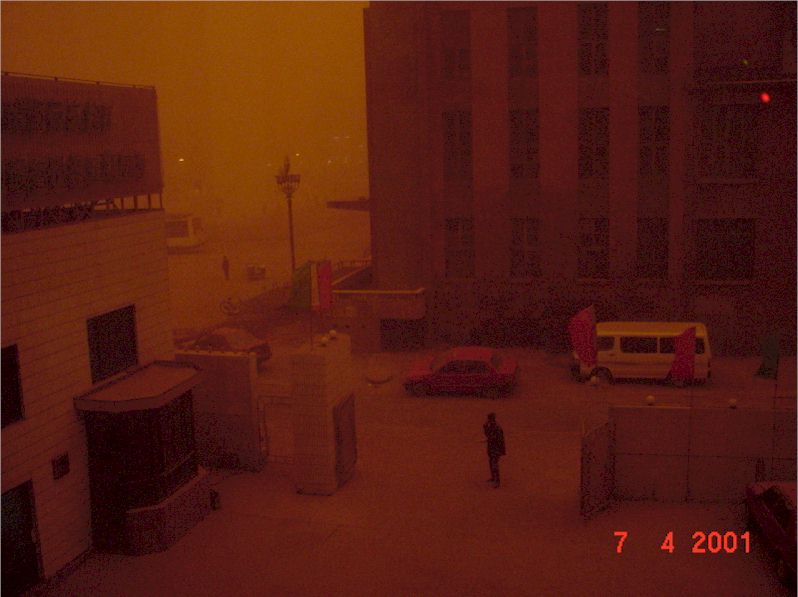
These dramatic pollution events can engulf the entire Great Basin in a thick layer of haze that can reduced direct solar radiation, double the diffused radiation and have a dramatic impact on the visibility across the National Park system including the Grand Canyon, Bryce Canyon and Canyonlands. Visibility degradation from Asian dust cloud events can range from a whitish discoloration of the normally blue sky to a thick haze that reduces visibility to 30 miles or less. These dust clouds can contribute as much as 40 µg/m3 of fine particulate to existing background levels..
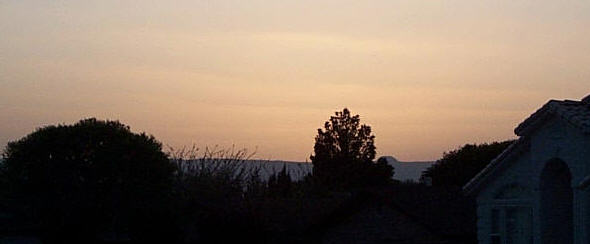
Asian Dust Cloud Over Page, Arizona - April 14, 2001
Grand Canyon Haze during 2001 Asian Cloud Event (Photo:
Tim Truman)
For more Grand Canyon Haze Pictures - Click Here


Glen Canyon National Recreational Area
April 16, 2001
Looking toward the Kaiparowits Plateau
Strong spring weather systems are capable of generating wind speeds of 60 mph which can last for days across the high steppe desert country of Mongolia and western China. Part of the reason these dust storms are so severe, is that the soil is so loose and fine. To quote Sven Hedin’s account Of the Takla-makan desert in 1895,
"...crossing a dead-flat plain of yellow-grey dust—nothing but dust, so fine that it blew like powder at every breath of the wind, and so soft and deep that driving over it was like an adventure on a feather-bed. The wheels of their wagons were almost sucked into it, the horses labored endlessly; the men, walking alongside, saw their feet sink into the dust ankle-deep with every step. The tracks they left behind were nothing but lines of dimples in the dust. The dust got into everything, the men and horses and every wagon became plastered with greyish-yellow dust."
These fine wind blown duststorms in China commonly referred to as "dust floatings".
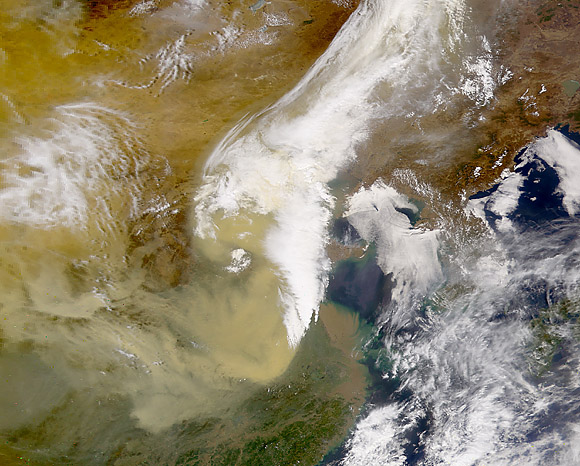
Where it all begins: Yellow dust cloud coming from the Gobi Desert (1998 image)
October 2000 Report - Chinese Monthly, the Internet
Beijing has always been violently invaded and attacked by air- borne sand and dust, so whenever a windstorm occurs sand and dust fill the sky. There are times when it continues for several days and the ground is then completely covered with a thick layer of sand. Under such weather conditions people have to remain indoors as much as possible, and if you risk going outdoors you have to take care not to be hit by the trees, the store signs, etc. that are being blown down by the wind, and moreover you have to wear a protective mask or veil. Since the sand can readily enter the eyes and mouth, the respiratory systems and eyes of many people are infected in this manner. In addition to the fact that sandstorms cause such inconvenience in people’s lives, they also influence agricultural production, transportation and shipping, and other industries, and cause serious economic damage thereby.
A report by the Chinese Academy of Science has indicated that this sand comes from the degraded pastureland and dry land of the area around the deserts of Inner Mongolia. Records show that during the 17th century there were from 0.3 to 1.0 sandstorms in Inner Mongolia per year, but by 1990 the annual rate of occurrence had risen to 3.0 to 5.0 times per year. At the same time, the rate of occurrence of sandstorms in Beijing has also increased, and the number of violent sandstorms that occurred this spring in Beijing was more than three times the average for the same period in the 1990s. Some have called the sandstorm that occurred on April 10, 2000 the most serious such storm in 10 years. Other than natural factors like aridity being the cause creating such conditions, the fact that China’s ecological environment has suffered damage is also a major source of this calamity.
Owing to the development of agriculture, the area of land adversely affected by sand has gradually increased, and during the 1950s and 1960s the land affected by sand expanded on average by 1,600 square kilometers per year. By the 1990s, the area by which this land was expanding had reached 2,500 square kilometers per year. This kind of situation where the land is adversely affected by sand is particularly serious in many regions upwind from Beijing. Fengning City in Hebei Province and Duolun City in Inner Mongolia lie to the north of Beijing, and in the last 50 years the population of these two cities has grown by a factor of 2 to 3 times. In order to obtain the resources needed to sustain their livelihood, the inhabitants have engaged in excessive cultivation of the land, pasturage of animals and tree-cutting, with the result that vegetation and the topsoil have sustained damage, and the sand layer below the earth is now exposed on the ground and the ground is rapidly being subjected to the spread of sand.
China has already noticed this problem, and has adopted remedial measures. Currently there have been measures taken in response such as the withdrawal of land from cultivation and pasturage and its return to forestland and grassland in regions like Hebei Province and Inner Mongolia. The other day the Chinese government announced that it would invest more than 600,000,000 renminbi [TN: Chinese currency, aka yuan] to control Beijing’s sandstorms in the coming decade. Only by decreasing the damage caused by man and restoring the natural environment will it be possible to hold in check effectively the sources of the sand and dust and to improve the problem fundamentally.
Go to Page 2 -
Index
Go to Page 3
Index
Compiled by Paul Ostapuk
Send Comments to postapuk@canyoncountry.net